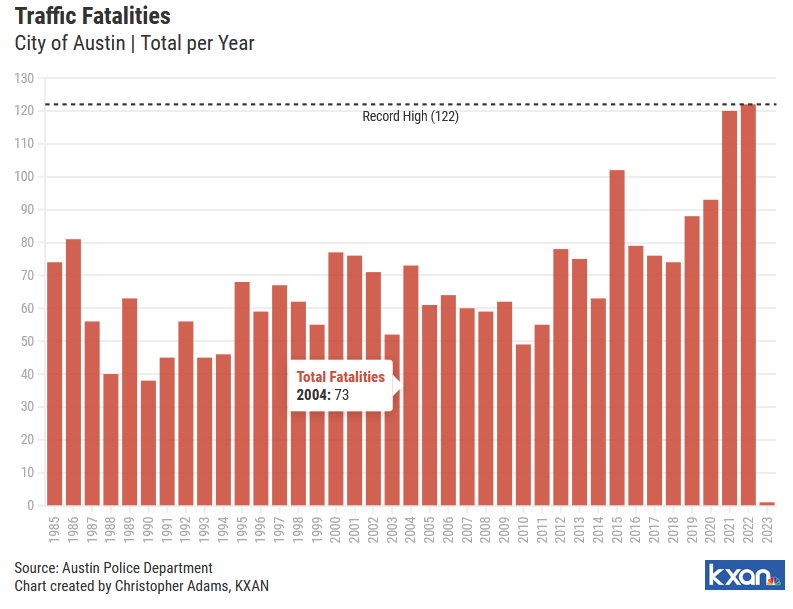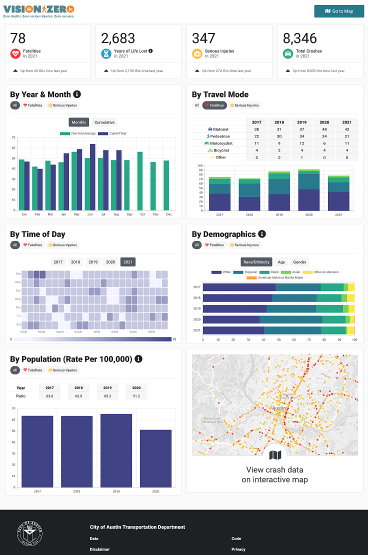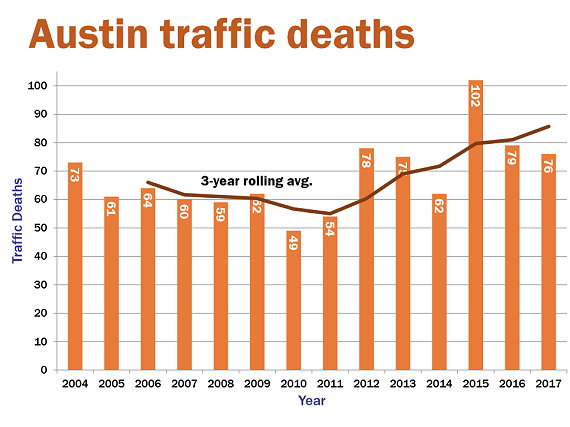December 20, 2021 – AUSTIN (KXAN) — While traffic fatalities continue to trend upward both locally and nationally, roadways undergoing improvements through Austin’s Vision Zero initiative are noting reductions in the number of severe crashes around the city. Data released by the Austin Transportation Department Monday reported a 17% reduction in severe crashes on high-injury roadways that have undergone recent enhancements. High-injury roadways are those areas with some of the largest concentrations of roadway crashes in the city.
The city has identified 13 roadways that account for some of the highest volume of crashes within Austin. Six of those 13 corridors identified by the city have recently received safety upgrades as part of the Vision Zero program:
- North Lamar Boulevard (U.S. 183 to Braker Lane)
- Cameron Road (E. St. Johns Avenue to Rundberg Lane)
- Riverside Drive (Lakeshore Boulevard to Montopolis Drive)
- South Pleasant Valley Road (Cesar Chavez Street to Oltorf Street)
- William Cannon Drive (Menchaca Road to Elm Creek Drive)
- Slaughter Lane (Menchaca Road to Interstate 35)

What safety improvements have been made?
While Austin has a wide network of local and arterial corridors throughout the city, Meyer said the majority of Austin’s most severe crashes happen on a relatively small set of roadways. These, comprising the HIR network, have been the sites of Vision Zero’s most concerted safety upgrade efforts.
Roadway improvements implemented include installing flashing yellow arrows or converting intersections to include protected left turn signals, to encourage speed reduction or designate time for turning traffic. Other changes made are added plastic road delineators, which can help guide and separate pedestrian and vehicle traffic through intersections.
Which roadways will be treated next?
Meanwhile, construction on three HIR corridors is currently in the works:
- E. Martin Luther King Jr. Boulevard (Airport Boulevard to Johnny Morris Road)
- Airport Boulevard (Manor Road to Springdale Road)
- S. Congress Avenue (Ben White Boulevard to William Cannon Drive)
Meyer said all city transportation officials have completed analyses on these three roadways and begun street improvements. These changes include those made at the six other HIR corridors, as well as signal timing improvements. Future work is planned for Parmer Lane from Metric Boulevard to Dessau Road; Burnet Road from U.S. 183 to MoPac Expressway; North Lamar Boulevard from Koenig Lane to U.S. 183; and South 1st Street from Stassney Lane to Slaughter Lane.
“In 2022, we are going to be looking at a few other of the high-injury roadways and start to do analysis, and really dig into the crash types and patterns that we’re seeing on those roadways,” Meyer said, adding upgrades will likely begin in mid- to late-2022.
Why are severe crashes decreasing, while traffic fatalities are rising?
While Meyer noted these improvements are a sign the city is trending in the right direction, fatalities are still increasing at the local and national level. Vision Zero data released by the city reported that, within a five-year period, 350 people have died in traffic-related accidents on HIR corridors. As of Monday, more than 100 traffic-related fatalities have occurred on Austin roadways this year alone, up 30% from 2020. Following this latest data release, Meyer said it’s encouraging conversations at the city level on how to expand these changes throughout Austin’s road network, in an effort to reduce traffic fatalities. Still, he said traffic experts across the country have tried to theorize why these fatalities are increasing at high volumes nationally.
“There’s been a lot of speculation that a lot of that has to do with changes that are happening during the pandemic: less traffic overall is actually leading to more speeding and more opportunities for people to do dangerous behaviors like impaired driving or distracted driving,” he said. “This is a trend that we’re going to continue to monitor and try to understand how those travel behaviors are changing and what we can do to address those.”




